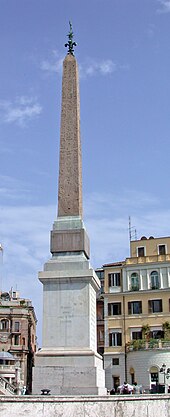Obelisco Sallustiano
The Obelisco Sallustiano is an obelisk in Rome . It crowns the Spanish Steps in front of the Santa Trinità dei Monti church .
description
The 14 meter high obelisk was carved out of rose granite in Egypt and brought to Rome without any inscriptions. Only there were the hieroglyphs attached. This is an imitation of the inscription on the obelisk in Piazza del Popolo .
The inscription on the base gives an indication of the place where the obelisk was found. Pope Pius VI calls the obelisk there OBELISCUM SALLUSTIANUM. In ancient times, the Sallust Gardens were located between the Quirinal and the Pincio . There, near today's German Archaeological Institute , the obelisk was first mentioned in the 4th century by Ammianus Marcellinus (17.4.16) and the obelisk was there until the 8th century. In the 16th century it was reported in reports that it was broken into several pieces and lying on the ground. At the beginning of the 18th century it was first brought to the Lateran, but not erected there.
It was not set up at its current location until 1789. There had been a long dispute between the Pope and the French king about its establishment at this point. The Pope wanted to give his primacy over King Louis XV by erecting it on the stairs that were paid for and commissioned by the French king . express who wanted to be immortalized there with an equestrian statue. For many years nothing happened and only in the years 1787 to 1789, when the French king had increasingly other worries , the obelisk was opened by Pope Pius VI. erect. On February 13, 1787, Goethe saw the start of excavation work for the foundation of the obelisk and, during his trip to Italy, also passed on how the design of the monument was mocked in the Carnival of 1788 because the base was felt to be disproportionately high.
The original base of the obelisk, which remained at its original location in the gardens of Sallust, was found during the construction of the German Evangelical Church in Rome in 1912 and placed on the Capitol under Benito Mussolini in 1926 and became the "Altar of the Fallen Fascists" ("Ara dei Caduti Fascisti") who died in the march on Rome .
See also
literature
- Cesare D'Onofrio: Gli obelischi di Roma. Rome 1967.
- Erik Iversen: Obelisks in exile. Vol. 1: The obelisks of Rome. Gad, Copenhagen 1968.
- Klaus Bartels: Rome's speaking stones. 2nd edition, von Zabern, Mainz 2001, ISBN 3-8053-2690-4 .
Web links
- The Roman Obelisks ( Memento from September 19, 2008 in the Internet Archive )
- Obelisco Sallustiano (Italian)
Individual evidence
- ↑ In 1787 he noted: “The foundation for the new obelisk is being dug on Trinita di Monte, (...)” In 1788 he reports in the section The Roman Carneval : “We remember one single suggestive mask. An obelisk was to be erected in front of the Trinità del monte church. The audience was not very satisfied with it, partly because the space is tight, partly because a very high pedestal had to be built under the small obelisk in order to raise it to a certain height. One of them therefore took the opportunity to wear a large white pedestal as a cap, on which a very small reddish obelisk was attached. (...) “- Johann Wolfgang Goethe: Italian journey . Edited by Andreas Beyer and Norbert Miller. In: Karl Richter u. a. (Ed.): All works according to the epoch of his work. Munich edition . tape 15 . Carl Hanser Verlag, Munich / Vienna 1992, p. 201 and 584-585 . - Johann Wolfgang Goethe: Italian journey . Special edition according to Volume 11 of the Hamburg edition. Ed .: Herbert von Eine. 6th edition of the special edition. Verlag C. H. Beck, Munich 1998, p. 168 and 494-495 .
Coordinates: 41 ° 54 ′ 22.2 " N , 12 ° 28 ′ 59.6" E
